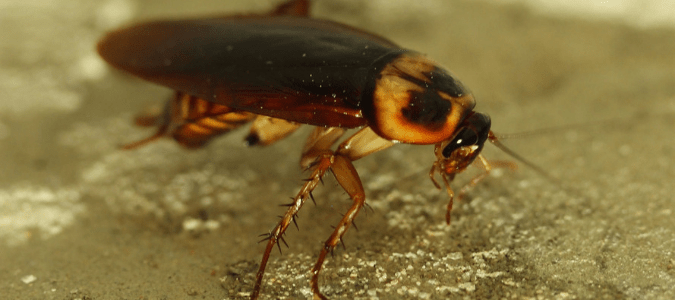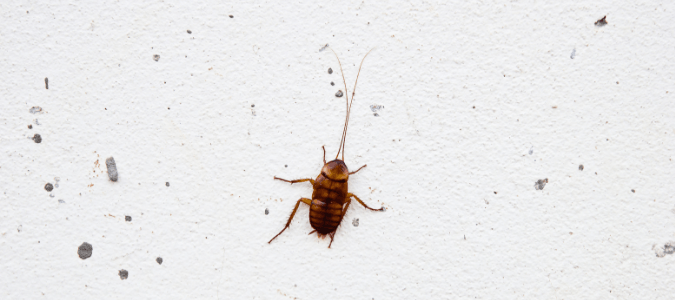German Vs. American Cockroach: How Do They Differ?

Speaking of their differences in size, there are some clear differences between German and American cockroaches that make them easy to distinguish from one another. In the end, of course, they’re all roaches, so they have plenty of similarities, but if you’re wondering about how to tell if a roach is of the German or American variety, look first to their appearance.
German cockroaches are small, typically around a half-inch in length and a quarter-inch in width. They are a yellow-ish brown color with darker brown stripes on the shield that lies just behind their heads; these stripes might extend past the shield and down the full length of their wings. Like their American cousins and other cockroach species, German roaches have flat bodies with six legs and two antennae extending from their heads. American cockroaches, on the other hand, typically grow to around an inch-and-a-half long and a half-inch wide, and are reddish-brown in color.
American cockroaches might be found living either indoors or outdoors, while German roaches are more likely to infest the interior of a home or restaurant. Both varieties of cockroach are typically more active at night, which is why it’s such a common phenomenon to encounter these creatures in your kitchen or bathroom when it’s dark outside.
When it comes to eliminating these pests from your home, the approach will be similar, whether you’re dealing with German cockroaches, American cockroaches or any other variety.
While German cockroaches and American cockroaches are the two most common species we come across, there are other species of cockroaches that can invade our homes and yards here in the Lone Star State.

Cockroaches In Texas
There are many different species of cockroaches in Texas. German and American roaches are just the top two most prevalent varieties, but there are several others commonly found throughout the state. With warm temperatures throughout much of the year and several densely populated urban centers, including the capital city, many portions of Texas are an ideal breeding ground for many varieties of cockroaches.
When cockroaches move indoors, you’ll probably spot them in the kitchen, where these pests have a readily available food and water supply. American cockroaches will also make themselves right at home in utility rooms, where clothes washers and dryers provide both water and warmth, or inside kitchen or bathroom cupboards, which provide warmth and shelter, as well as a nearby water source from the shower or sink, and even a food supply in the form of toilet paper rolls or cardboard boxes. American cockroaches can live and thrive almost anyplace indoors that is near water and warmth, such as near water pipes in the basement, attic or walls.
This is why cockroaches love cohabiting with humans—because we provide them with so many things they need and enjoy, namely the all-important basics for nearly any animal or insect: food, water, shelter and warmth. Roaches love the crumbs and smears left over after a typical meal in a kitchen or dining room. These pests will happily dine on bits of fruits, vegetables, cheese, meats, bread and crackers. Cockroaches will also just as happily consume paper, cardboard, ink and glue. They’ll even resort to eating other insects, in some situations.
Most people have all of these food sources readily available in their homes, and not just in their kitchens. Books on shelves, boxes in closets or storage rooms, paper napkins and plates or the paper labels on wine or condiment bottles in the pantry can all provide an excellent food source for roaches. This is why it’s so difficult to completely cut off a cockroach’s access to food inside the home, since they can eat and thrive on such a wide variety of substances.
Cockroaches also need water to survive, and cutting off their access to water inside the home can be a bit easier than cutting off their food supply. Roaches can get water from a variety of indoor sources: dripping faucets, water that pools in pipes in the bathroom or laundry room and even moisture from the dirt in your houseplants. If you’re dealing with a cockroach infestation in your home, whether German, American or another species of cockroach, you should fix any leaking faucets or pipes, remove any areas of standing water and try not to overwater your plants.
How do you know you’re dealing with a cockroach infestation, as opposed to something else?

Common Roach Infestation Signs
There are many common roach infestation signs that can alert homeowners to the presence of cockroaches living inside their home. The first sign, of course, is spotting a cockroach—or more than one—whether alive or dead. In the case of American cockroaches, spotting only one is not always a sign of an infestation; it’s possible that the roach simply wandered in from outdoors. If you see more than one, however, or if you see these roaches only one at a time but on a regular basis, it’s more likely that they are living in a colony inside your home. And in the case of German roaches, spotting even just one is a likely sign of a full-blown infestation.
Another sign of a cockroach infestation is spotting their egg cases, which indicate the presence of roaches that are mating and reproducing. American cockroach egg cases are usually hardened, reddish- or dark-brown, pill-shaped cases that are about three-eighths of an inch in length. German cockroach egg cases are similar, but lighter in color (more yellowish or medium-brown), slightly smaller (one-quarter inch to three-eighths of an inch) and banded or ridged.
Where do cockroaches lay eggs? Homeowners might find roach egg cases anywhere roaches might be, but they are often deposited in hidden-away places such as in corners beneath cabinetry, or attached to furniture, walls or folded bedding inside linen closets.
The presence of cockroach feces is another sign of an infestation. German cockroach waste materials look like small, dark bits of dirt or coffee grounds, while American cockroach feces look like small, light- or dark-brown spots or smears. These might be found on walls, inside cabinets or drawers, on shelves or even on sheets, towels and other linens.
For homeowners with sensitive senses of smell, these pests’ distinctive scent can be yet another sign of a cockroach infestation. American cockroaches are more likely to give off a particular smell than German cockroaches, and this smell is stronger and more noticeable when the roaches are actively mating.

What Attracts Roaches?
All cockroaches, no matter what variety or in which region of the country or world they are found, are in search of the basics that draw most pests to your home: food, water, shelter and warmth. But what attracts roaches in particular? German and American cockroaches are attracted to similar things that attract ants and other unwanted pests, such as food or crumbs left out on counters, or dirty dishes left in the sink (or even in the dishwasher). Roaches are also attracted to sources of water inside homes, such as water that pools inside pipes or drains or in potted plants.
Since roaches are also attracted to books, cardboard boxes, paper, glue and ink, they might also take up residence in a storage room, attic space or library area of the home. Since there are so many things inside the home that attract roaches, if you want to eliminate cockroaches and prevent future infestations, your strategy should include not just killing off the pests in all their life cycles, but also limiting their access to food and water, in order to make your home a less attractive place for them to live.

How To Get Rid Of Roaches
Cockroaches aren’t just startling or unsightly; they are also unsanitary and actually pose many risks to human health. Many people have an allergic reaction to roaches and their feces, and cockroaches have been linked with asthma. These creatures can also contaminate food sources and storage areas with their feces and secretions.
Cockroaches do not have a specific mating season; unfortunately, this means they mate year-round, and many species are highly prolific. Female American cockroaches, for example, might produce hundreds of babies in a year, or upwards of a thousand, while female German cockroaches can produce tens of thousands of babies each within a single year! Most roaches mature to adulthood in just a few weeks’ time, and a typical lifespan for many roach species is about one to two years.
Since many roaches deposit their egg cases in protected, hard-to-see places, it can be difficult to eradicate them at all stages of their life cycle, but any comprehensive approach to pest control will attempt to eliminate cockroach eggs as well as every stage of this insect’s life cycle up through adulthood.
Some homeowners swear by certain DIY roach-killing methods, such as sprinkling boric acid around areas where there is evidence of the presence of roaches. Boric acid is toxic if consumed, however, so many pest control professionals advise homeowners against using it in areas where dogs or other pets might accidentally get it on themselves or lick it off the floor. It’s also not a great option if you have newborns or toddlers, as there are many other options of pest control with baby safety as a priority.
Cats, spiders and certain kinds of lizards are natural predators of cockroaches, so households where these animals live may be more naturally roach-free. Bringing in cats and spiders isn’t a very effective approach, however, when you’re dealing with a cockroach infestation; nor is using boric acid around your home, especially if you have children or pets. Many homeowners are understandably concerned about using the type of roach-killer products that are readily available in stores, since most chemicals commonly used to kill cockroaches and other unwanted insects are toxic, and some have even been linked to cancer.
For many homeowners, the best way to get rid of a German cockroach infestation, an American cockroach infestation or any other infestation of unwanted pests, is by hiring a professional exterminator to address the problem with a comprehensive, multi-point strategy.
Chem-free Can Handle Your Cockroach Problem
Chem-Free Organic Pest And Lawn Services is a leader in providing effective, low-impact pest control that’s tough on bugs but not tough on children, pets and the environment. Our experienced pest control specialists will determine the scope of your cockroach problem and then develop an effective and comprehensive extermination plan that utilizes environmentally friendly products and approaches. We can also set up a schedule for return maintenance visits to ensure that cockroaches never again take over your living space or give you an unpleasant surprise late at night.
Need Help Managing Pests?
Chem-Free offers both effective, low-impact pest control options and preventative measures to help avoid future infestations. Contact us today for a free estimate!


